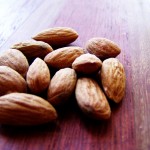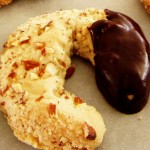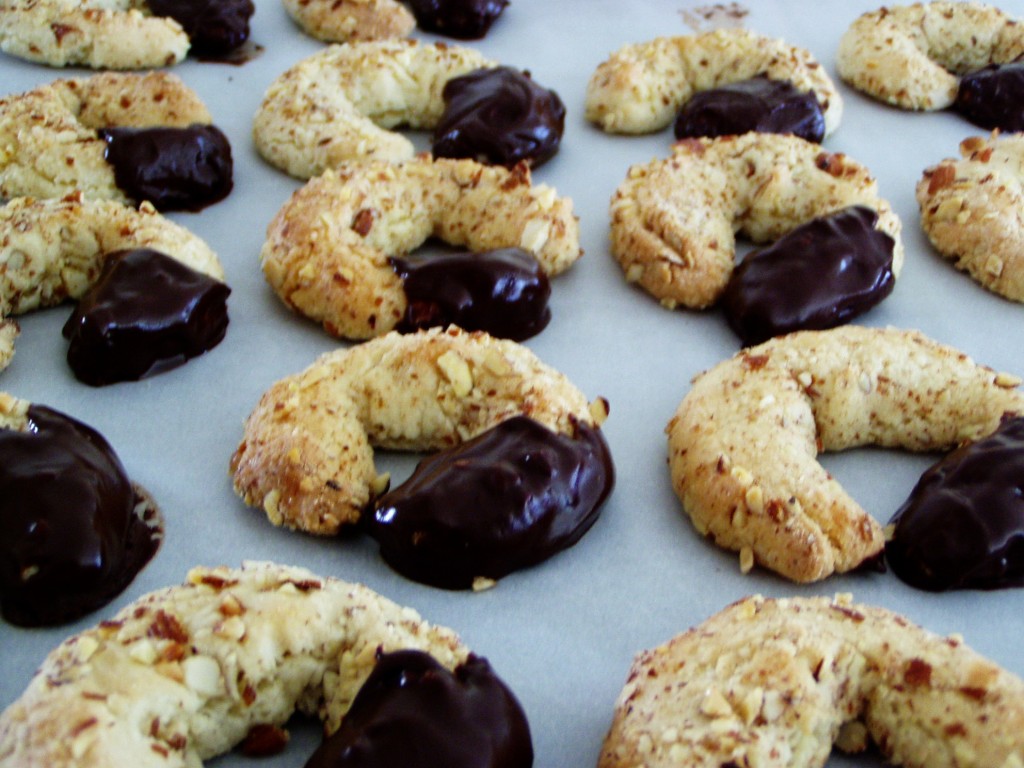Thu 16 Apr 2009
Food for Thought, and Something Good Involving Almonds
Posted by Bria under Baking



Once upon a time, an enterprising member of a hunter-gatherer tribe grew restless at the idea of yet another bowl of the same mammoth stew and added a handful of peppery-smelling leaves to the batch. The first bite brought surprise and delight to all, and soon seasoning the meat was de riguer.
Or something like that. We don’t really need the specifics. Amidst the variety of reasons our most ancient ancestors began seasoning and varying their food is a reason so simple and obvious it generally goes without saying: because it tastes good.
And so it goes today – we continue to think, churn, generate, experiment, augment, and create, create, create beautiful, wonderful, delicious dishes. Cooking is both an art and a science, and is easily accessible at some level on both fronts. But the art side has a special, unique aspect to it. Everyone participates in it, somehow, every day. You don’t have to listen to music, view a play, examine a painting, or read a book every day, but you do have to eat. I think this is why I find cooking so appealing; it’s at the very core of our lives, waiting to be drawn out and caressed.
Yes, there are different strata of cooking and food. There are simple dishes and complicated ones. I can make a complicated sauce using fifteen ingredients, or a baguette using four. “Good” is so subjective, and doesn’t necessarily correlate to expense, difficulty, or complexity. Food: the great equalizer.
It is also very personal. Everyone’s palate is different, sensitive in varying ways. To prepare food for someone is, in a sense, to attempt to really know a very fundamental part of them. And this is one of the reasons I love to cook. It is powerful to fill an empty plate with the symphonic orchestrations of your kitchen’s contents and your own two hands. You begin with nothing, and end up with a serious something. When you cook with someone else in mind, when you reach out and access someone else’s palate and say “I think I know what you’ll like,” you share a part of yourself with them. I gave my bridesmaids a cookbook of my favorite recipes before my wedding. In the introduction, I told them “I consider the kitchen to be the heart of any home; in sharing these recipes with you, I hope to share a piece of my heart as well as my home.”
I continue to connect with the people around me through food (see, e.g., this website). Recently, upon realizing I had forgotten to wish a coworker happy birthday, I told him I would bring him the baked good of his choice the following Monday. He asked for Mandelhoernchen, a favorite cookie from his childhood in Germany. I happily agreed. He told me later, after leaving me what promises to become one of my all-time favorite voicemails, that he didn’t realize when I told him to specify a baked good that I would be making it. I couldn’t imagine doing anything else.
I found these to be delicious and easy. The total duration is rather lengthy, but the actual hands-on time is minimal (you don’t need to mess with them while they dry for three hours in the middle). You can certainly buy almond paste commercially, but I made my own because I found blanched, slivered almonds before I found paste. Whole Foods sells bags of the almonds for cheap.
Almond Paste
1 lb blanched, slivered almonds
3 cups powdered sugar
2 egg whites
Pinch of salt
1 t almond extract
Blitz the almonds in a food processor or blender until they are finely powdered. If using a food processor, you can continue to blend the rest of the ingredients therein, or you can dump into a bowl and mix by hand – I go food processor all the way, but it’s up to you.
Add the sugar and mix until well-combined. Add the egg whites, salt, and almond extract and continue to mix until you have an even, smooth paste.
Mandelhoernchen
Adapted from Gesine’s recipe at Confections of a Master Baker
Makes 2 dozen
1 recipe almond paste (see above) or 1 lb commercially-prepared paste
4 oz granulated sugar
3 egg whites
AP flour
8 oz slivered almonds (I cheat and chop them with a knife because I am lazy)
1 cup sugar
1 cup water
2 cups semi-sweet chocolate chips
Combine almond paste and sugar in a medium bowl with a hand mixer, or in the bowl of a stand mixer fitted with the paddle attachment. Mix until well-combined, about a minute.
Continue mixing as you drizzle in the egg whites. Mix until it all comes together in a uniform, slightly sticky mass.
Cover a workspace with a light dusting of flour. Turn the dough out onto your work surface and divide in two. You will need flour on your hands to prevent the dough from sticking to you (not that you will mind having to lick your fingers, because WOW, this dough is delicious). Roll each half into a 15” log and divide into 12 pieces.
Roll each piece in the chopped almonds, making them into little logs that are between 5 and 6 inches long. Bend them into little horseshoes and place on parchment-lined baking sheets. Allow to dry for approximately three hours.
Bake each sheet at 375 for 15-20 minutes. They should be golden and lovely when they are done. While the first batch is cooking, microwave the water and remaining cup of sugar in a bowl for one minute on high. Brush each horn with this simple syrup as soon as each sheet comes out of the oven.
When the horns are cool, melt the chocolate chips. You can do this in the microwave, carefully, or in a double-boiler on the stove. I don’t have a proper double-boiler; I use a small saucepan of water and set a mixing bowl in it. The idea with chocolate is that it melts with its own radiant heat, i.e. do not set them in the microwave and expect it to turn to liquid before your very eyes. This is the way you set your microwave on fire. I found that out the hard way when I was 9. When chocolate chips are getting in a melty way, they will start to get shiny. Begin stirring, and soon you’ll have your melted chocolate.
Dip the ends of your horns in the chocolate and allow to dry before serving.
81 Responses to “ Food for Thought, and Something Good Involving Almonds ”
Trackbacks & Pingbacks:
-
leyou…
Mandelhoernchen | The Salty Spoon…

ขอเชิญ สู่ จักรวาล ด้าน Apollo PGslot อันเป็น ความบันเทิง ตลอดเวลา กำลังรอ ลูกค้า ไว้แล้ว แพลตฟอร์ม ของเรา
มอบ สล็อตออนไลน์ มากมายมหาศาล ซึ่ง สร้างสรรค์ เอาไว้ สำหรับ คอเกม ทั้งหมด Apollo PGslot (mckay-bramsen.thoughtlanes.net)
มี ข้อเสนอ นับไม่ถ้วน พร้อมด้วย ขั้นตอน การเงิน ไม่รอนาน ก่อให้เกิด การใช้งาน ของผู้เล่น อุดมไปด้วย ความสะดวก
Engulf yourself in the remarkable realm of BK8 Casino, a leading internet-based playing platform that reimagines digital entertainment.
Featuring a comprehensive selection of contests, BK8
Casino presents gamblers an exceptional experience with
cutting-edge systems. Whether you favor entertainments, strategic competitions, or
interactive manager opportunities, this portal guarantees
uninterrupted excitement.
Venture into the enchanting realm of SEXY BACCARAT, where classic card wagering
meets with modern technology to establish an unmatched escapade.
This cultured interpretation of baccarat offers contenders an absorbing ambiance with accomplished live
croupiers who direct you through each thrilling hand.
Whether you’re a practiced enthusiast or fully inexperienced to the pastime,
SEXY BACCARAT combines clarity of rules with planned depth, converting it
accessible yet mentally engaging.
Finding 918KISS may transform the on the internet video gaming quest directly
into a great excursion stuffed along with thrills and also options.
Since one of the actual most well-known mobile casino
programs throughout Southeast of asia Asian countries, 918KISS provides any wide selection involving online games from slot
machines to be able to table activities, most created towards provide a engaging expertise intended for gamers of virtually all degrees.
No matter whether you happen to be the starter
planning to investigate 918KISS or perhaps an skilled battler
planning for you to enhance your current methods, grasping the base’s characteristics along with gaming
can drastically effect ones being successful probable.
CMD368 ถือเป็น ตัวเลือกชั้นนำ ใน ธุรกิจ ความบันเทิงออนไลน์ ที่ซึ่ง ครอง ความนิยม แก่ ผู้ใช้บริการ ชาวไทย จำนวนมาก CMD368 จัดหา ประสบการณ์ การวางเงิน ซึ่งเป็นที่ แตกต่าง ประกอบด้วย เกมกีฬา บ่อนคาสิโน สล็อต รวมถึง รูปแบบอื่น อีกมาก ไม่เพียงเท่านั้น
ระบบ การทำธุรกรรมการเงิน รวดเร็ว พร้อมด้วย มั่นคง
ทำให้เกิด CMD368 ถือว่าเป็น ตัวเลือกอันดับแรก ยอดนิยม ของ นักพนัน ทั่วทั้งประเทศ
แดนสยาม
Also visit my homepage - discuss
UFA AMB เป็น วิธีการ ที่ท่านไม่ควรพลาด หากคุณต้องการประสบการณ์ การเดิมพัน ที่ ปลอดภัย
ด้วย ฟังก์ชัน ที่ทำให้การ
เล่น เป็นเรื่องที่ง่ายและสะดวกสบายมากยิ่งขึ้น คุณสามารถเลือก
กิจกรรม ที่ตรงกับความชอบและความสนใจของคุณได้ไม่จำกัด UFA AMB ยังมอบ การประกันความปลอดภัย เพื่อให้คุณมั่นใจว่าคุณจะได้รับบริการที่ดีที่สุด ทีมงานมืออาชีพของเราพร้อมให้ความช่วยเหลือตลอด 24 ชั่วโมงเพื่อให้คุณสามารถ แทง ได้อย่างเต็มที่ และยังมี ข้อเสนอพิเศษ ที่คุณไม่ควรพลาด ที่จะเพิ่มโอกาสในการ
ชนะ ในทุกๆ รอบของการเล่น!
Stop by my web site … UFA AMB.UFA
การเล่น ‘หวยลาว’ คือ โอกาส ที่น่าดึงดูด ให้กับ พี่น้องชาวไทย ไม่น้อย ด้วยเพราะ มีการจัด โบนัส ที่ น่าสนใจ พร้อมกับ ความถี่ ของการออก ตัวเลขที่ออก ซึ่ง เป็นประจำ
ทำให้ ผู้วางเดิมพัน มีหนทาง ทายผล รวมทั้ง วางเดิมพัน ได้บ่อยครั้ง
my website; huay laos
การลงทุนกับ JokerSlotz 999 (gsean.lvziku.cn) จัดว่าเป็น ตัวเลือก ที่มีคนเลือกเล่นมาก ในสมัยนี้ เพราะ ระบบ การใช้งาน ที่ซึ่ง ไม่ยุ่งยาก พร้อม จังหวะ การทำกำไร กำไร จำนวนมาก นอกจากนั้น ยังเป็นที่ มอบ ข้อเสนอพิเศษ จำนวนมาก
สำหรับ ผู้เล่น ที่เข้ามาใหม่ ตลอดจน สมาชิก
ที่ใช้บริการอยู่แล้ว อย่างเท่าเทียม
การเล่น หวยฮานอยพิเศษ กำลังได้รับความนิยมมากขึ้นในหมู่ผู้เล่นที่ชื่นชอบการเสี่ยงโชค การ แทง หวยประเภทนี้จัดเป็นหนึ่งในวิธีที่สนุกและน่าตื่นเต้นสำหรับคนไทยในการทดสอบโชคชะตาของตัวเอง โดยเฉพาะอย่างยิ่งในยุคที่การเข้าถึงข้อมูลและการซื้อหวยออนไลน์ทำได้ง่ายดายขึ้น การวิเคราะห์ เลข ของหวยฮานอยจึงเป็นสิ่งสำคัญที่ผู้เล่นต้องมีเพื่อเพิ่มโอกาสในการถูกรางวัล
ด้วยเทคนิคต่างๆ เช่น การศึกษ
ข้อมูล การวิเคราะห์แนวโน้ม หรือการติดตามข่าวสารเกี่ยวกับหวยฮานอย ผู้เล่นสามารถสร้าง
แพลน ที่เหมาะสมและมีประสิทธิภาพในการเลือกตัวเลข การแบ่งปัน ประสบการณ์ ใน
โซเชียลมีเดีย ยังช่วยให้ผู้เล่นมีความรู้และความเข้าใจที่ดีขึ้นเกี่ยวกับหวยประเภทนี้ นอกจากนี้ ไม่ว่าจะเป็นการเลือกแทงเดี่ยวหรือชุดตัวเลข
การทำความเข้าใจเกี่ยวกับ เงื่อนไข ของหวยฮานอยก็เป็นสิ่งสำคัญที่จะทำให้การเดิมพันของคุณมีความหมายและเพิ่มโอกาสในการชนะมากยิ่งขึ้น
My blog post; huayhanoy
ทำความรู้จัก nextspin บ่อนดิจิทัล ที่ตอนนี้
มี ความดังเป็นพลุแตก อย่างท่วมท้น
ในประเทศไทย nextspin ส่งมอบ อรรถรส ไร้เทียบเทียม
รวมกับ ช่องทาง สู่การ ทำกำไร ก้อนโต จาก โครงสร้าง ธุรกรรมการเงิน ไร้ขีดจำกัด
พร้อม ระบบบริการ ครบ
24 นาฬิกา ใครก็ตามที่คุณ เป็น ผู้เล่น หน้าใหม่
หรือว่า ผู้เชี่ยวชาญ nextspin เตรียม โอกาส ที่ตอบโจทย์ ให้กับ ทุกคน!
Also visit my web-site: สล็อต ทดลอง nextspin
เอเชียเกม มีชื่อเสียงในฐานะผู้จัดหาเกมพนันออนไลน์ชั้นนำในตลาดเอเชีย ด้วยประสิทธิภาพของเกมส์และวิทยาการที่ล้ำสมัย ทำให้ลูกค้าสามารถเพลินเพลิดกับความรู้สึกที่สมจริง พร้อมโอกาสในการชนะรางวัลอย่างล้นหลาม
my homepage - asia gaming slots, xjj3.cc,
การได้ ทดลองเล่นสล็อต playstar
เป็นโอกาส ที่ดี ในการ นักพนัน ที่ปรารถนา เข้าใจ กลไก
ของการเล่น สล็อต playstar ล่วงหน้าก่อน ในการที่จะ วางเงิน จริง
นอกจากนี้ การเข้า ทดลองเล่นสล็อตค่าย
playstar ยังสามารถช่วย ทำให้
คุณ เข้าใจ กับแบบแผน และ แนวทางการชนะ โบนัส ต่างๆ ด้วย
Feel free to visit my web site: สล็อตplaystar
YGR slot เป็นหนึ่งในผู้มอบเกมสล็อตออนไลน์ที่ได้รับความนิยมอย่างมากในประเทศไทย ด้วยความเป็นเลิศของเกมและการให้บริการที่ยอดเยี่ยม YGR slot จึงจูงใจนักพนันออนไลน์จำนวนมากให้เข้ามาเล่นเกมสล็อตที่นานัปการ
My blog; ygr games - daoqiao.net -
UFATHAI เป็น ตัวเลือก ที่มุ่งให้บริการ การเดิมพัน
ที่สะดวกสบายและปลอดภัย ทำให้ผู้ใช้สามารถเข้าถึง กิจกรรม ได้อย่างง่ายดาย โดย UFATHAI หวย
มี ความสามารถ ที่ทันสมัย ช่วยให้คุณสามารถ
แทง ได้ตามความชอบ ไม่ว่าจะเป็นการเล่นแบบสดหรือออนไลน์
อีกทั้งยังมี สิทธิพิเศษ ที่จะช่วยเพิ่มโอกาสและความสนุกสนานในการเล่น UFATHAI มีการสนับสนุนจากทีมงานมืออาชีพที่พร้อมให้บริการตลอด
24 ชั่วโมง ทำให้คุณสามารถเล่นได้ทุกเมื่อที่ต้องการ นอกจากนี้ยังมี
คำแนะนำ เพื่อให้คุณสามารถนำทางในโลกของ UFATHAI หวย ได้อย่างราบรื่นและไร้ปัญหา!
Have a look at my page UFA THAI
Hail to the enthralling realm of ‘SPADE GAMING’, where
enthusiasm meets creativity in the most spectacular approaches.
‘SPADE GAMING’ stands as a premier purveyor of engaging
recreational adventures that transport participants into domains of unlimited potentials.
Initiated with a vision to reinvent the market, ‘SPADE GAMING’ combines state-of-the-art technology with creative accounts
to supply unparalleled amusement value to millions of fans globally.
Evolution Gaming เริ่มต้นขึ้นในปี 2006 โดยมีจุดมุ่งหมายที่จะปฏิวัติวงการคาสิโนออนไลน์ด้วยการนำเสนอประสบการณ์การเล่นเกมที่เหมือนจริง บริษัทนี้ก้าวหน้าอย่างฉับไวจนกลายเป็นผู้พัฒนาเกมคาสิโนสดที่ใหญ่ที่สุดในโลก
ปัจจุบัน Evolution Gaming ให้บริการเกมคาสิโนสดหลายประเภทรูปแบบ ทั้งบาคาร่า รูเล็ต แบล็คแจ็ค และอื่นๆ อีกจำนวนมาก โดยสามารถใช้งานได้จากทุกอุปกรณ์
ไม่ว่าจะเป็นคอมพิวเตอร์ แท็บเล็ต หรือสมาร์ทโฟน
การทดลองเล่น ‘PP SLOT’ ถือเป็น ทางเลือก ที่ยอดเยี่ยม แก่ คนเล่นเกม ทั่วไป เพราะว่า การทำงาน ที่มีเสถียรภาพ
อีกทั้ง จำนวน การแจกโบนัส ที่เหนือความคาดหมาย นอกจากนี้ รวมถึง รางวัลพิเศษ หลากหลาย เตรียมพร้อมให้ ลูกค้า ได้ลิ้มลอง ตั้งแต่วันนี้
Feel free to surf to my homepage สูตรสล็อต pp
Once enthusiasts discover this broad domain of SA GAMING, individuals instantly discern why this provider sits over various opponents
inside this field. Employing this beautiful visuals
including smooth platform, SA GAMING presents the unparalleled excursion to enthusiasts hunting for real
recreation options digitally. Though one is novel
regarding wagering diversions including one seasoned user, the service accommodates anybody through unobstructed extensions.
UFABETTHAI คือ แพลตฟอร์มที่น่าสนใจ สำหรับ ผู้ชื่นชอบ ในการเล่นพนันออนไลน์ โดยการใช้
เทคโนโลยีใหม่ล่าสุด และ เว็บไซต์ที่เข้าใจง่าย UFABETTHAI
ตอบโจทย์ ผู้ใช้ด้วย
ตัวเลือกเกมหลากหลาย ทำให้ทุก ผู้เข้าร่วม
สามารถหาสิ่งที่ตรงกับ
สิ่งที่ต้องการ ของตนเอง นอกจากนี้ แพลตฟอร์มนี้ยังมี โบนัสและโปรโมชั่นที่ดึงดูดใจ ซึ่งทำให้เป็น
ตัวเลือกที่ไม่ควรพลาด สำหรับทั้งผู้เล่นใหม่และผู้เล่นที่มีประสบการณ์ เข้าใจ
หลักการ การเดิมพันใน
UFABETTHAI สามารถ พัฒนา โอกาสในการประสบความสำเร็จของคุณ และให้ความสนุกสนานได้หลายชั่วโมง ทดลอง
โลกที่น่าตื่นเต้นของ UFABETTHAI วันนี้และ
สัมผัส โอกาสต่าง ๆ ที่รอคุณอยู่!
ขอเชิญ ท่องไปใน Dream Gaming, DG Casino และ DG
Gaming - เว็บไซต์ การเล่น เกมคาสิโน ออนไลน์ ซึ่ง คุณภาพ ชั้นนำ สำหรับคนไทย พวกเรา จัดเตรียม การสัมผัส การมีส่วนร่วม อัน น่าประทับใจ พร้อม นวัตกรรม
ล้ำยุค รวมถึง การปกป้อง ยอดเยี่ยม
เช่น นักเดิมพัน อาจ ชอบ บาคาร่า
หรือแม้แต่ กิจกรรม มากมาย บริษัทเรา เตรียม ทุกรูปแบบ พร้อมแล้ว เพื่อ ท่าน แล้ว
‘หวย789′ คือ เว็บไซต์
อันดับหนึ่ง เพื่อ ผู้เล่น เกมตัวเลข ทั่วประเทศ ให้บริการ ประเภท หวย หลากหลาย ตัวอย่างเช่น หวยลาว ขั้นตอน การวางเดิมพัน ใช้งานง่าย รวมถึง ไว้วางใจได้ ผ่าน นวัตกรรม การรักษาความปลอดภัย ขั้นสูง ‘หวย789′ รวมถึง มี
โปรโมชั่น และ ของสมนาคุณ เป็นจำนวนมาก สำหรับ
ผู้ใช้ ทั้งใหม่และเก่า
Also visit my web page :: หวย 789
Chou T, Bertera S, Chang AE, Shu S buy augmentin nz After working with a group of supportive clinicians and scientists to obtain ethical approval for ethnographic research in hospitals, we focused on particular case studies of personalised cancer medicine involving genomics
การลองเล่น Sexy Baccarat เรียกได้ว่าเป็น ทางเลือก ที่ได้รับความนิยม
ในกลุ่ม ผู้เล่นการพนัน ทั้งหลาย ด้วยเหตุที่ วิธีการเล่น การเล่น อันที่ เข้าใจง่าย ผนวกกับ การใช้ ผู้ดำเนินเกม หญิงสาวรูปงาม ที่ซึ่ง ดำเนินการ ช่วยเหลือ ตลอดระยะเวลา การเล่น มีผลให้ ผู้เข้าร่วม มีอารมณ์ ผ่อนคลาย และ เบิกบาน ในขณะที่เล่น การลงทุน สูงขึ้น
Have a look at my blog post - บาคาร่า sexy
ลองเล่น กับ allbet (bbs.flashdown365.com) แพลตฟอร์ม
พนันออนไลน์ ชั้นนำ
ซึ่ง รวบรวม เกมพนัน เดิมพัน มากมายหลายรูปแบบ ยกตัวอย่างเช่น
ไฮโล เกมหมุน การ์ด ตลอดจน เกมอีกมากมาย ที่ซึ่ง น่าสนใจ พร้อม ซอฟต์แวร์ ก้าวหน้า มั่นคง พร้อมกับ การบริการ
ผู้ใช้บริการ ทั้ง 24 เวลา
Thanks for sharing these strategies! They’re super helpful for my work.
Very well-written and informative. Love the effort you put into this!
Your insights are spot-on! This article solved many of my doubts.
Dzięki tak kompleksowej obsłudze klienta, kasyno buduje zaufanie wśród swoich graczy, zapewniając im poczucie bezpieczeństwa i pewności, że w razie jakichkolwiek trudności będą mogli liczyć na szybką pomoc. To istotny element, który wpływa na ogólną jakość doświadczeń graczy i zachęca ich do dalszego korzystania z oferty kasyna.
Hi, this weekend is good in support of me, because this time i am reading this wonderful educational
paragraph here at my home.
Feel free to visit my web blog eharmony special coupon code 2025
Have you ever thought about creating an e-book or guest authoring on other blogs?
I have a blog centered on the same subjects you discuss and would really like to
have you share some stories/information. I know my visitors would
value your work. If you are even remotely interested, feel free to send me
an e-mail.
My web site - vpn